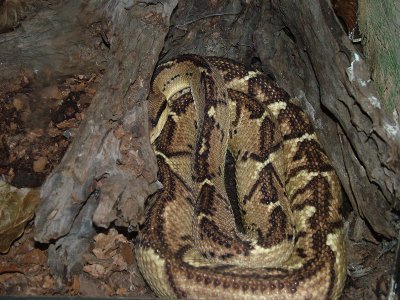Center American Bushmaster Snake
Category: Snakes

Facts about Central American Bushmaster snake. "Scientific name of the Central American Bushmaster snake is Lachesis stenophrys". Central American Bushmaster snake is a Lachesis type of venomous snake that is one among the affiliates of the Viperidae family. These snake varieties are prevalent in the northern parts of South America and Central America. The Central American Bushmaster snake are largely found in Central America in the Atlantic plains of the southern parts of Nicaragua, Panama and Costa Rica, including the Pacific plains of eastern and central Panama. The Central American Bushmaster snake can also be seen in South America in the Pacific plains of Colombia and the northwestern part of Ecuador, the Caribbean coastline of northwestern Colombia and interior along the Cauca and Magdalena river gorges.
Features of Central American Bushmaster snake
The Central American Bushmaster snake is a large-size snake that can attain a maximum body length of 200 cm (79 inches) when fully grown and sometimes, it may grow to a maximum length of 330 cm (130 inches). The Central American Bushmaster snake has a brown and gray color body, with a sequence of dark black or brown color blotches markings running the whole length of the body as well as the tail. The Central American Bushmaster snake variety appears with a broadly spherical rounded head, with uneven scales, and with an upturned nose with distinct body scales, keeled and very rough. Usually, the Central American Bushmaster snake has a distinct mid dorsal ridge that is most different on the last sector of the body. The color pattern of their body is darker than other varieties in the family.
The Central American Bushmaster snake has very long fangs, which function similar to hypodermic needles intended to pierce deeply, snatch and grip onto prey as the snake injects its injured party with immobilizing poison. Snake poison delivered by this snake variety has influential Hemotoxic characteristics having an effect on the circulatory system obliterating red blood cells, producing organ deterioration and generalized tissue harm that can be lethal if left untreated.
Usually, the Central American Bushmaster snake lives in humid rainforest and lower Montane damp forest where yearly rainfall averages between 2,000 mm (78 inches) and 4,000 mm (157 inches) , which are deep to very heavy rainfall. In the drier regions of Nicaragua, they live in gallery forests, including in forests that are seasonally arid, but then on no account, far from resources of water. The Central American Bushmaster snake variety is scarcely ever encountered exterior of the old growth forest.
Behavior of Central American Bushmaster snake
The Center American Bushmaster is nocturnal in temperament, and has received the fierce status, recognized to violently attack humans. These snakes are recognized to attack aggressively, particularly when startled or agitated. Though these snakes attack only rarely, they are greatly panicked by people native to their jungle home. The Central American Bushmaster snake is one among the biggest and most hazardous snakes in South America, and it is competent of several bite strikes, injecting a huge amount of poison and even the bite of a young Bushmaster can be lethal.
Reproduction of Central American Bushmaster snake
The Central American Bushmaster snake is an oviparous snake variety, which means they are different from other pit vipers, such that they do not bear live juvenile, but lay eggs. The female Central American Bushmaster snakes will give birth to 4 to 12 young snakes that will be hatched during the spring season.
The average lifespan of the Central American Bushmaster snake ranges from 12 years to 18 years.

 Back To Category Snakes
Back To Category Snakes